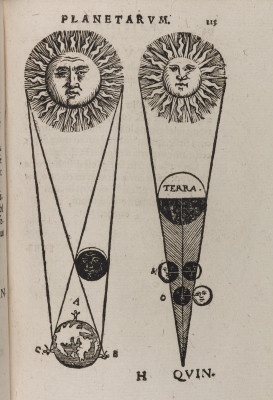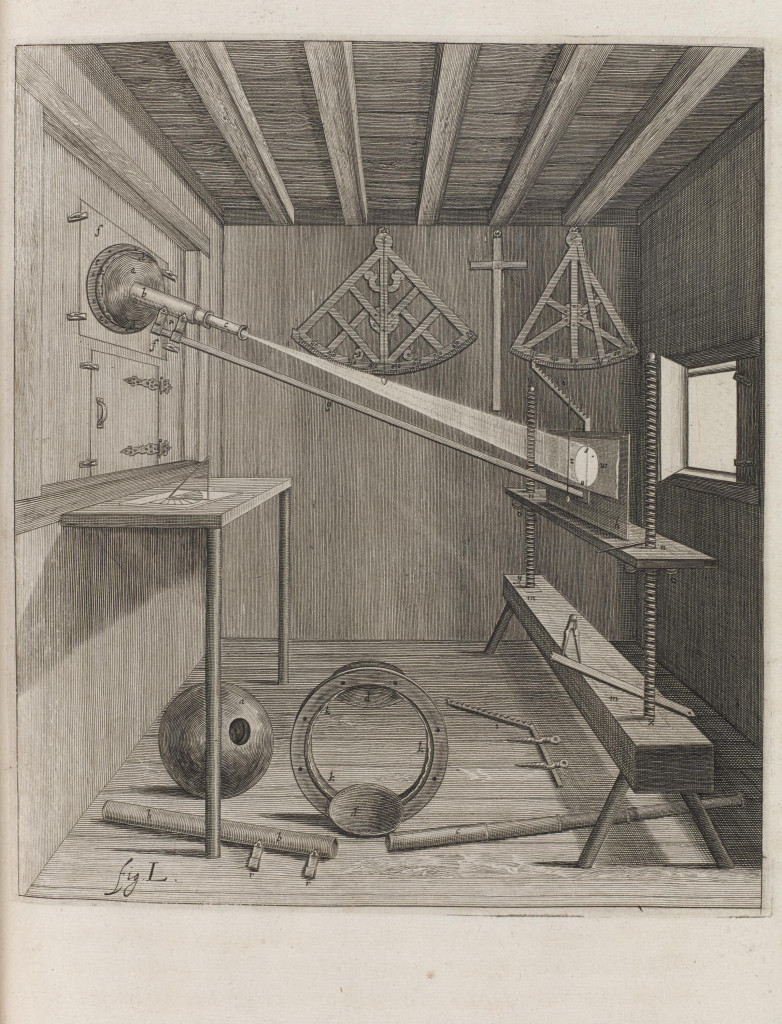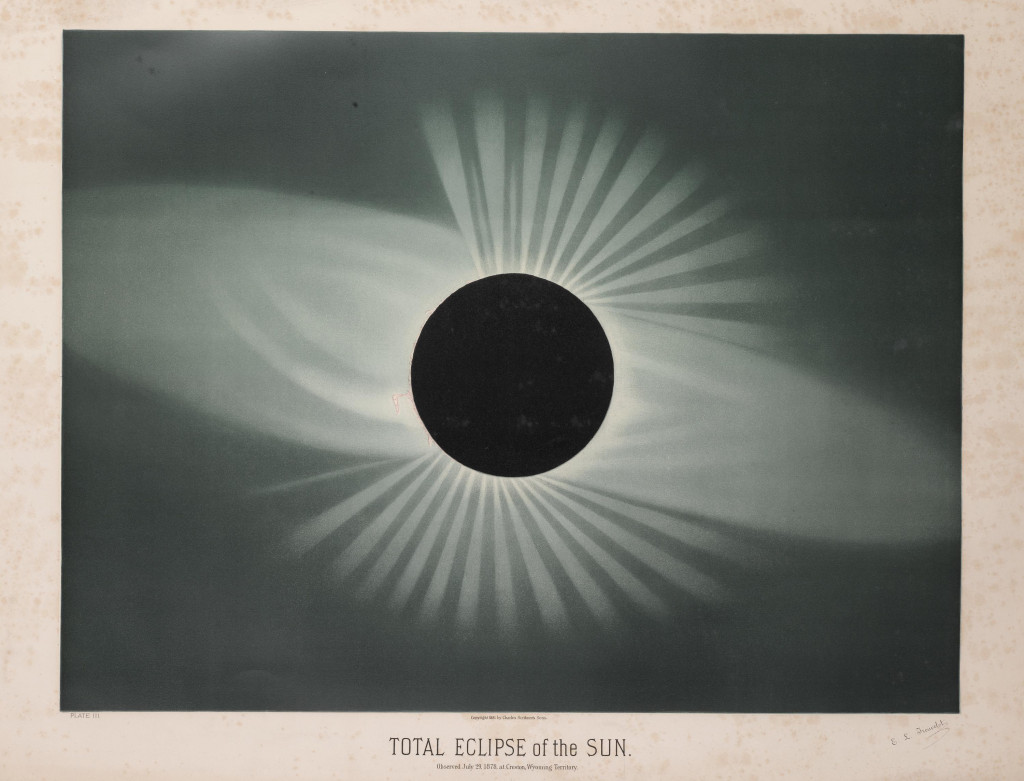Since the dawn of human consciousness, a total eclipse has been seen as unsettling, even frightening, a short-lived triumph of evil over good that was thought to be a bad omen.
Attitudes towards this drama changed over the millennia, first with ancient calendars that charted the rhythms of the heavens, then with increasingly accurate scientific observations of the moment when the Moon snuffs out the Sun.
As this way of thinking took hold, the eclipse morphed from a mystical into a natural phenomenon.

But the chilling appearance of an apparent hole in the sky also provides a fascinating portal through which to view the culture of the day, according to a paper published this week, just a few days before the shadow of an eclipse will race across central Africa.
Even though the advent of photography would come to solve a number of scientific puzzles about eclipses, artists still played ‘a surprisingly important role’ until relatively recently, according to Ian Blatchford, Director of the Science Museum Group, in his paper for an eclipse-themed issue of the journal Philosophical Transactions of the Royal Society A.
Eclipse art, he says, reveals there were ‘intriguing occasions when the artistic eye has been of real utility to the scientific process.’
Given the remarkable theatre of total eclipses, it is no surprise that there is a long tradition of depicting them in Western art, although these representations have changed in a way that is ‘culturally fascinating and surprising,’ remarks Blatchford, who is an art historian by background.
Many might think that early artists were influenced more by religion, superstition and aesthetics than a scientific worldview, not least because the Gospels recall how the sun was obscured around the time of Christ’s death on the cross.
That binary view is borne out in pre modern art, from sacred ivories to illuminated manuscripts and panel paintings, which are heavy with symbolism and iconography.
Among examples cited by the Director are the Metz Sacramentary, created for the Bishop of Metz around 850, which represents the church with a mourning Moon, and the Echternach Gospels (c.1050) in which the Sun and Moon are personified and the eclipse adopts the form of figures ‘shrouding their faces in grief’.
But the story then becomes more complicated because, as Blatchford explains, ‘artists could respond both spiritually and rationally to eclipses.’
As the Renaissance gathered pace from the end of the 15th century onwards, depictions became more realistic, mirroring the rising influence of astronomical thinking: the Regiomontanus Kalendarium of 1476 depicts the phases of a solar eclipse, and a fresco created by Raphael and his workshop for the Vatican – around the time that the shadow of an eclipse crossed Italy – seems to depict an annular eclipse, when the Moon is farther away in its orbit than usual, and does not quite cover the Sun’s disk (as will be the case on September 1, when one will be visible from Madagascar and Central Africa).

Depictions of eclipses evolved in the Age of Enlightenment thanks to sophisticated observations made by telescope. The Polish Lutheran astronomer Johannes Hevelius (1611–1689) also shows a darkened room in an engraving – a technique that he himself mastered- to illustrate how to safely observe the Sun and eclipses. ‘It is a striking image and very important in the history of science,’ says Blatchford.
By the eighteenth century, research on our local star began in earnest, notably by Edmond Halley, whose studies of an eclipse in 1715 represent a pioneering example of citizen science, and who also reported the phenomenon of Baily’s Beads (named after Francis Baily who in 1836 observed how beads of sunlight lingered along the edge of the Moon in an annular eclipse).
The eerie and evocative image of the eclipse became democratised too. Once only depicted for churches, royal patrons and scholarly tomes, eclipses began to feature in the popular science books of the day, such as Astronomy Explained (1757) by the Scottish Astronomer James Ferguson.
They were also used to humorous effect in a satirical print in which General Wellington is shown eclipsing the monarch George IV (An Eclipse Lately Discovered in the Georgium Sidus), to shed light on a spat over the emancipation of Catholics.
The Science Museum’s extensive collections of guides, models and pamphlets show how tracking and observing eclipses became a fad in the early nineteenth century. ‘There was burgeoning middle class interest in science at that time when people at polite dinner parties talked about what they got up to with telescope as much as literature,’ says Blatchford.
All the while, scientific observations became ever more detailed. The Kew Photoheliograph was the first astronomical instrument designed for photographing celestial objects and was used in Northern Spain to photograph the 1860 total eclipse, helping to resolve the debate as to whether prominences were intrinsic to the Sun or atmospheric effects.
Yet, remarks Blatchford, ‘the artist remained a valued part of the professional eclipse expedition.’ One example is to be found in the ‘glorious chromolithographs’ of a total eclipse in Wyoming in 1878, produced by Etienne Trouvelot which are ‘all the more remarkable when compared with an ‘accurate’ modern digital photography.’
The view of this cosmic event that Trouvelot recorded during his experience of a few minutes of totality is as rich as some digital composite images. Comparison shows them to be ‘so alike that it takes your breath away,’ says Blatchford: the active combination of eye and brain is powerful when compared to the passive collection of light through a lens.

Even in the 20th century, artists still made a contribution. American portrait painter Howard Russell Butler was invited to paint the 1918 eclipse by the US Naval Observatory, for example. A series of his paintings supported the growing consensus among researchers that a luminous area encircling the darkened body of the Sun—the corona—was the Sun’s atmosphere. ‘For a long time it was thought the corona was part of the moon’s atmosphere,’ explains Blatchford.
Eventually, however, ‘the sheer quality of photography came to supplant the role of artist as essential companion of the astronomer; and so the eclipse was used by artists in new guises, both symbolic and abstract.’
Around turn of the 20th century, eclipse art became prophetic. In an illustration produced for On the Moon, written in 1887 by Konstantin Tsiolkovsky, Russian scientist and pioneer of the cosmist movement, one can witness a solar eclipse like no other seen before by human eyes: the Earth eclipsing the Sun.
A solar eclipse makes a sombre appearance in work of the Russian symbolist painter Nicholas Roerich in his Prince Igor’s Campaign of 1942, which Blatchford argues is a reference to Russian armies marching east to confront a Europe eclipsed by Nazism.
Towards the end of the 20th century, depictions became more playful, such as one by Roy Lichtenstein who depicted time-lapsed versions in his Eclipse of the Sun II. When it comes to the future, however, Blatchford says that ‘painting an eclipse on a canvas will probably fade away with the rise of digital.’
The Science Museum is now planning a major exhibition about the Sun in 2018. It is remarkable, says Blatchford, how this central feature of everyday life has been neglected in modern culture.
Ian Blatchford’s richly-illustrated paper was first presented at an ‘eclipse festival’ to coincide with the last solar eclipse visible in the UK, in March 2015, organised by Giles Harrison, Professor of Atmospheric Physics at Reading University.
Harrison said that eclipses played a key role in the history of science, from the rise of citizen science in 1715, when Edmund Halley used Philosophical Transactions to ask colleagues across the country to help him observe a total solar eclipse (Harrison organised a meteorological citizen science experiment, NEWEx, which provided data despite the cloudy weather in 2015), to the use of an eclipse of Jupiter’s moon Io to make the first estimate of the speed of light, to Sir Arthur Eddington’s famous test of the bending of starlight predicted by Einstein’s theory of general relativity during the 1919 solar eclipse.
In his paper on ‘eclipse meteorology’, Harrison recounts how the predictable decline in solar radiation in these natural experiments, when day turns into night and temperatures drop, can help weigh up how the atmosphere responds to an external stimulus on a regional scale (10–1000 km). This work is invaluable for honing weather prediction models, and can be used to help plan for transient reductions in renewable electricity generation too.
